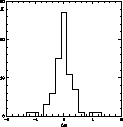![]()
where ![]() is in mJy. To compute the spectral index between
408 MHz and 10.6 GHz (presented in Fig. 3a) the low-frequency flux densities
were
increased by 5% to
is in mJy. To compute the spectral index between
408 MHz and 10.6 GHz (presented in Fig. 3a) the low-frequency flux densities
were
increased by 5% to
adjust them to the scale of Baars et al. (1977). The spectral indices of B30226+394, B30241+393B, B30920+408, B31016+388B, B31428+385, B31447+402, B32333+397, and B32348+387 were not included; the VLA maps show that the components of these triple sources are probably not physically connected.
![\begin{figure}
\epsfxsize=8cm
\begin{center}
\epsfbox [65 190 560 688]{ds1562f3.eps}
\end{center}\vspace*{5mm}
\vspace*{2mm}\end{figure}](/articles/aas/full/1998/19/ds1562/Timg36.gif) |
Figure 3: Histograms of spectral indices between 408 MHz and 10.6 GHz. a) for the whole sample, b) for POSS-I galaxies, c) for empty fields, and d) for quasars (see text) |
 |
Figure 4:
Histograms of ratios of component flux densities of double
sources at a) |
For the decomposed double sources (see Sect. 2) Table 3 presents in Col. 1
the B3 source names, in Cols. 2 and 3 the positions (equinox B1950.0) of the
components from
Vigotti et al. (1989); Cols. 4 and 5 give the flux densities at
![]() 2.8 cm and
2.8 cm and ![]() 20 cm
(Vigotti et al. 1989), respectively.
For each source we have
computed the component ratio R2.8 of the flux density at
20 cm
(Vigotti et al. 1989), respectively.
For each source we have
computed the component ratio R2.8 of the flux density at ![]() 2.8 cm
(see Fig. 4a), and the ratio R20 of the flux density at
2.8 cm
(see Fig. 4a), and the ratio R20 of the flux density at ![]() 20 cm,
then the
ratio R=R2.8/R20 (see Fig. 4b). These ratios were computed
considering as the first component the brightest one at 20 cm.
Figure 4a shows
that the double sources at
20 cm,
then the
ratio R=R2.8/R20 (see Fig. 4b). These ratios were computed
considering as the first component the brightest one at 20 cm.
Figure 4a shows
that the double sources at ![]() 2.8 cm
2.8 cm
are symmetric with respect to the flux densities; in fact only 18% have a ratio greater than 2 (very high values could also be an indication that the two components are not physically connected). Figure 4b shows that only 10% of double sources change their flux density ratio between 1.4 and 10.6 GHz by more than a factor of 2.
 |
Figure 5:
Histogram of the difference |
We are grateful to H. Rottmann and G. Zech for their invaluable help during the many observing runs. We wish to thank our referee, Dr. J.J. Condon, for his useful comments. Part of this work was supported by the Deutsche Forschungsgemeinschaft, grant KL533/4-2, and by the European Commission, TMR Programme, Research Network Contract ERBFMRXCT97-0034 "CERES''. We thank Dr. H. Andernach for a careful check of the tables.
Copyright The European Southern Observatory (ESO)